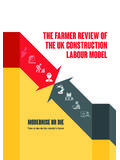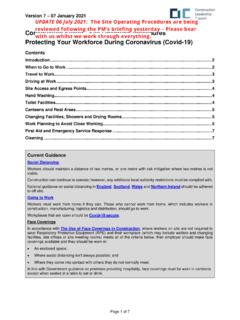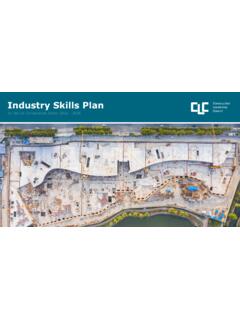Transcription of The Farmer Review of the UK Construction Labour …
1 The Farmer Review ofthe UK ConstructionLabour ModelModernise or DieTime to decide the industry s futureThis Review adopts a structure of evaluating the Construction industry s current and future state which has a strong medical process analogy: Identify the symptoms Diagnose the root causes Provide a prognosis Establish a treatment plan for recovery Keeping the industry under observationResearched and written by Mark Farmer , Founding Director and CEO, Cast by the Construction Leadership Council (CLC). Follow Mark on twitter: @MFarmer_Resi views expressed by the author are not necessarily those of the CLC oranyone connected with the CLC. Neither the author nor the CLC accept anyliability arising from the use of this data or analysis from this report must be reported accurately and notused in a misleading context. If using any information from the report, then its source and date of publication must be acknowledged. COPYRIGHT Mark Farmer 2016 Published October 201601 Construction Leadership Council Foreword2 Introduction4 Executive Summary61.
2 A Symptomatic Analysis of the Construction Industry122. A Diagnostic Assessment of Causation423. A Business as Usual Prognosis for the Future464. Recommendations A Treatment Plan for Transformational Change505. Keeping the Industry under Observation Success Factors686. Next Steps70 Farmer Review : Original Terms of Reference71 Abbreviations and Acronyms72 Acknowledgements73 Introduction02 The Farmer Review of the UK Construction Labour ModelConstruction Leadership Council ForewordAt the end of last year the governmentasked the Construction LeadershipCouncil to identify actions to reducethe industry s structural vulnerability toskills shortages, taking account of theCouncil s wider work including that onbusiness models and offsite Council welcomed this task is to be Ministers go-tosource of senior industry advice on thesector s major issues, and there is nomore important question for Construction than this Review has been carried out forthe Council by Mark Farmer , CEO ofCast Consultancy, and I am verypleased to present his report.
3 It doesnot, however, make for comfortablereading. It is not the first report to setout the shortcomings of the sector slabour model, and prevailing businessmodel, though few have done so insuch a cogent and compelling is new, though, is the force ofthe conclusion that given workforceattrition exacerbated by an ageingworkforce we simply cannot go on aswe report focuses in particular onhousing, reflecting the original commission. In fact, while differentparts of Construction have differentfeatures, this issue is to be foundthroughout the sector. In infrastructure and commercial propertythe skills challenges arising from previous underinvestment are similarlypressing, and the imperative to actsimilarly strong. Here too we find the survivalist business model, the absence of alignment between industry and client interests, and ofthe incentives and means to invest,that Mark recognises are the heart of the simply, much of the industry doesnot make enough money, or, wheremoney is being made, feel enoughconfidence it will stay profitable intothe future.
4 The consequence is underinvestment in training and development, in innovation, in raisingproductivity. The challenge the reportsets us is to do things differently toreduce the reliance on building in thesame way that we have for decades ifnot centuries, with its heavy demandfor on-site Labour . We will not havethe Labour force to deliver what thecountry needs by working in thoseways, and those ways will not createenough added value for clients or suppliers to allow Construction firms toprosper, and make those investmentsin our people and the report says, this is a challengefor all the industry, its clients, andgovernment. Its recommendations arefocussed on finding and unlocking thedrivers of change, including action tosupport predictability of demand, andon leadership to own the is in part a role for the LeadershipCouncil and its workstreams, though itwill depend on the industry and itsclients joining the recommendations are well framedin recognising other work currently taking place.
5 In July the governmentannounced it will Review the Construction Industry Training Board(CITB). That is a key organisation forthis agenda, and the Council wouldlike the Review to be radical to be theforce for the changed industry that weneed requires a changed organisation,with a remit centred on developing theskills of the future, and efficient andeffective delivery and use of its we were asked to carry out thiswork the country has voted to leavethe EU. This has highlighted again thegrowing reliance of some trades insome regions on migrant Labour , andonly underlined further, if that werenecessary, the imperative to make ourindustry one that trains and developsthe people we need. Last, I should like to record the Council s gratitude to Mark Farmer and the colleagues who have supported him. We are enormously grateful for all the time and hard workand insight he has brought to the the best thanks we as an industry could give him would be tomake this report the moment whenthe recognition that we cannot go onas we are reached its tipping Wolstenholme OBECo-Chair, Construction LeadershipCouncil04 The Farmer Review of the UK Construction Labour ModelIn accepting the daunting challenge ofleading this Review , I was very clear inmy mind that this had to be an exercise that led to change.
6 This wasnever going to be just another reportabout the Construction skills crisis inisolation, it had to look much deeperat the fundamentals of how we deliverand why. There are numerous studiesthat analyse the well-rehearsed woesof the Construction industry. Many alsolook to exemplars of activity to illustrate how things might be done at scale in a Utopian world. These approaches are both important butonly in the context of how we then usethat knowledge to effect modernisationand improve our industry at a strategiclevel. The hardest challenge for this Review was always going to be how toavoid a straight rehearsal of what wealready know, and really focus on whatthe fundamental change agents areand how this can be connected into an industry-wide transformation programme. This Review is thereforedeliberately as much about the how as the what and why .I was given clear terms of reference(page 71) and guidance from both Department for Business, Energy & Industrial Strategy (BEIS) and the Department for Communities andLocal Government (CLG), which included not expecting a big pot of taxpayer money to throw at the problem.
7 In addition, the overarchingguidance from the Construction Leadership Council has been clear do not pull any punches, look to challenge accepted norms and indeedbe controversial if it will provoke debate and lead to the desired outcomes. This Review has looked to cover theground in terms of taking soundingsand evidence across many areas ofthe Construction industry, with a particular focus on house building. It has become clear during the courseof this work that the most importantand effective drivers for change do notnecessarily sit within the industry itselfso a more holistic view has had to betaken that heavily influences the nature of the recommendations contained the period of concluding thisreview, there have been tumultuousevents in British politics centered onthe decision to leave the EU. This hasmade the relevance of this Review evengreater with the need to find a homegrown solution to our problems nowcrucial, assuming less future relianceon migrant Labour .
8 Introduction05A by-product of the June 2016 referendum was a fresh governmentcommitment to industrial strategy .This is welcomed as the principlescontained herein can essentially beviewed as some of the building blocksof a strategy to create a modernisedand sustainable Construction may see elements of my conclusions as being harsh or negative and indeed some of the recommendations as being controversial or overly may also feel that the recommendations divert attention from the primary responsibility of theconstruction industry to resolve its own failings. This is not the intent and careful reading of this Review will hopefully demonstrate a balanced and integrated analysis of the evidence that has then been developed into a series of logic linked am hopeful that the issues identifiedand the principles established shouldenable all parties to step back and understand the seriousness of thepredicament facing the constructionindustry.
9 This also has direct ramifications for clients as end usersof the industry and government as thecustodian of the UK s economic andsocial welfare. I am very clear that ifwe do not address in short order howthe Construction industry operates anddelivers, we will see a long-term andinexorable decline in its fortunes. Thisis not just another must do better school report where the industry andits clients shrug their shoulders andcarry on as normal. This Review warnsof potential marginalisation and deterioration that might not be recoverable. I do not believe Construction s perilous future statewas so clearly evident at the time ofLatham s Constructing the Teamin 1994 or Egan s Rethinking Constructionin 1998. If this reviewdoes only one thing, it must be tobring the likely reality into acceleration of the wider digitalrevolution combined with a shrinkingtraditional Construction workforce aretwo issues I would highlight as beingcritical to the future fortunes of theconstruction industry.
10 One could arguethat the stars are aligning and now isthe time to allow the opportunitiesfrom digitisation to offset the risks ofcontinued reliance on Labour is important to clarify that I do notwant to create a divisive binary futureindustry where innovators or earlyadopters at the vanguard of changeleave the laggards in isolation. This isabout creating a vibrant, re-skilled,fully integrated, more predictable andproductive industry such that traditional working and new approaches can co-exist and complement each other, driving much wider longer-term interested parties should considerand reflect on the impacts set out inthis Review of potential industry decline, not only from their own perspective but also hopefully prompting the desire for us to collectively create an appropriatelegacy for future generations. I trulybelieve that being part of the engineroom delivering our nation s built environment and by implication, economic prosperity, offers a massively dynamic and fulfilling , continuing as we are is notan option if we are going to be able tomake that claim in the years Farmer ,October 201606 The Farmer Review of the UK Construction Labour ModelThe Construction industry and theclients that rely on it are at a critical juncture and it is time to Review the seriousness of the future outlook.















